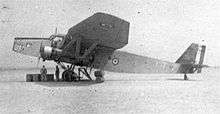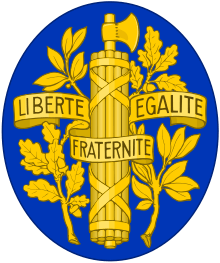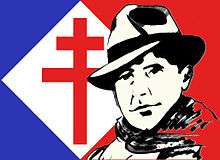Free French Africa
Free French Africa is the political entity which collectively represents the colonial territories of France on African soil which rallied to Free France formed by General de Gaulle during the Second World War in order to continue the struggle against Nazi Germany and the Axis forces.
Afrique française libre Free French Africa | |
|---|---|
.svg.png) Flag | |
 Free French Africa in November 1940, including Chad, French Cameroon, Ubangi-Shari, Gabon, French Congo. | |
| Capital | Brazzaville (1940–1944) Algiers (1943–1944) |
| Official language | French |
| Type | Federation |
| Membership | |
| Leaders | |
• President | Charles de Gaulle |
| Establishment | August 1940 |
It provided a political and territorial base for Free France and strengthened General de Gaulle's international position. It made a major contribution to the war effort by financing the French Resistance, by the contribution of its many soldiers to the Free French Forces, and by the military exploitation of its installations and territories.
Because of its geographical location, Free French Africa offered a considerable asset to the Allies, favoring military operations out of Chad in the Western Desert Campaign in Egypt and Libya, as well as facilitating communications across the continent, thus giving British colonies the ability to communicate with each other.
Political base of Free France

In the vast territory of Free French Africa, including French Equatorial Africa and French Cameroon, Charles de Gaulle was able to exercise full powers as head of Free France, on an equal footing with a head of state.
After passing through Douala in Cameroon, and Chad, he arrived in Brazzaville on 24 October 1940, which was already the seat of government both of French Congo, as well as of the regional government of French Equatorial Africa.
Brazzaville became the capital of Free French Africa and of all of Free France. It remained the capital until 1943, when Algiers took over.[1]
Contribution to the war effort
Personnel and military
The peoples of free French Africa were heavily involved in the war effort. Ten Marching Batallions[lower-alpha 1] were formed there from December 1940 to January 1943, each composed of six hundred to eight hundred men. At the cost of heavy losses, they distinguished themselves on various battlefields.
The Second Marching Batallion, or the Ubangi-Shari Batallion, particularly stood out at the Battle of Bir Hakeim, where it became the first land-based unit to become a member of the Order of Liberation. The Third Marching Batallion of Chad, was the only unit among French forces to take part in the East African campaign.[2]
Infrastructure

The strategic military situation of Free French Africa offered Free France and the Allies a vast support and communications base in the heart of Africa. As a result, air transport and other infrastructure were widely developed. Seven airports were renovated or built, including the Fort-Lamy and Pointe-Noire airports, completed in 1942.[2] The Brazzaville to Beirut airline was put into service in October 1941.[2]
Allied air force planes arrived disassembled and packed in crates, were rebuilt at Takoradi in the British Gold Coast colony, and transited through Chad, where they were able to stop at the new Fort Lamy airfield, before reaching the Middle East theatre of operations. Twenty thousand planes flew in or through Africa; 3,000 landed at Fort Lamy in 1942.[2]
Road infrastructure was also improved. New roads were built totaling 10,000|kilometers. The main priorities were military, towards the operational fronts. These were the Douala-Bangui-Jubba axis, connecting Ethiopia and the fronts of the East African Campaign; the Bangui-Fort-Lamy transverse axis, which was passable in all seasons; and the Fort-Lamy to Faya-Largeau axis for the Libya Operations Front and the Western Desert Campaign.[2]
Economic
French Equatorial Africa is nicknamed the "Cinderella" of French possessions in Africa, being less rich than North Africa or French West Africa. The four territories making it up are not of equal importance. Chad has vast regions of steppe and mountains, especially useful from a military point of view.[3] Gabon and French Congo produce oilseeds and wood. The population is quite large in Ubangi-Shari and Chad.[3] The Congo–Ocean Railway provides transport to the port of Pointe-Noire.[4]
French Cameroon, which was not part of French Equatorial Africa, joined Free France at the end of August. It is comparatively richer, with considerable and varied production, including citrus, cocoa, wood palm and various other resources. Its demographic potential is also important, with already 2.4 million inhabitants in 1936.[3]
See also
- Brazzaville Conference
- Empire Defense Council
- Foreign policy of Charles de Gaulle
- Foreign relations of Vichy France
- Free France
- French Indochina in World War II
- French Resistance
- French Colonial Empire
- French Fourth Republic
- French Third Republic
- Military Administration in France
- German occupation of France during World War II
- Italian occupation of France during World War II
- Liberation of France
- Liberation of Paris
- List of French possessions and colonies
- List of Governors-General of French Equatorial Africa
- Military history of France during World War II
- Philippe Pétain
- Provisional Government of the French Republic
- The Vichy 80
- Vichy France
- Zone libre
References
- Notes
- A marching battalion (Bataillon de marche) is a provisional unit composed of several companies formed in an unconventional manner. A unit is called a "marching" unit, when it is formed from elements of other units.
- Footnotes
- "De Gaulle et l'Afrique - Brazzaville, capitale de la France libre" [De Gaulle and Africa - Brazzaville, capital of Free France] (in French). Fondation Charles-de-Gaulle.
- Michel 2006, p. 318.
- Michel 2006, p. 317-319.
- Michel 2006, p. 317.
- Sources
- Michel, Marc (2006). "Free French Africa". In Marcot, François (ed.). Dictionnaire historique de la Résistance [Historical Dictionary of the Resistance]. Paris: Robert Laffont. ISBN 2-221-09997-4.
- Jennings, Eric T. (2014). La France libre fut africaine [Free France was African]. Paris: Perrin. ISBN 978-2-262-04739-9..
- Le général Leclerc et l'Afrique française libre, 1940-1942: Actes du colloque. Fondation Maréchal Leclerc de Hauteclocque et Institut d'histoire des conflits contemporains. 1988.
- "De Gaulle and Africa". charles-de-gaulle.org. Charles-de-Gaulle Foundation.
- Victoria Gairin (21 March 2014). "History: when Africa saved France". lepoint.fr. Le Point.
- "Afrique Française Libre - 1940 : Premiers rallies". edu.fondation-marechal-leclerc.fr. Fondation Maréchal Leclerc de Hauteclocque.
- Guy Vourc'h (September 1948). "Le ralliement de l'Afrique française : Les journées des 26, 27, 28 aout 1940" [The Rally of French Africa: the Days of 26, 27, 28 August 1940]. Revue de la France Libre (11).
- Andrieu, Claire; Braud, Philippe; Piketty, Guillaume (2006). Dictionnaire De Gaulle [De Gaulle Dictionary] (in French). Paris: Robert Laffont. ISBN 2-221-10280-0. : Empire :432-433; Ralliement des colonies :985-986
- Rowley, Anthony; Besset, Frédéric (2002). "Anthony Rowley". Dictionnaire d'histoire de France Perrin [Dictionary of the History of France Perrin]. Perrin. p. 420. ISBN 2-262-01321-7. OCLC 51096438.
- Sicé, Adolphe (1946). L'Afrique équatoriale française et le Cameroun au service de la France (26-27-28 août 1940) [French Equatorial Africa and Cameroon in the service of France (26-27-28 August 1940)] (in French). Paris: Presses universitaires de France. OCLC 11008104.
- Blanche Ackermann-Athanassiades (1989). France-Libre, capitale Brazzaville [Free France, capital Brazzaville] (in French). Editions La Bruyère.

